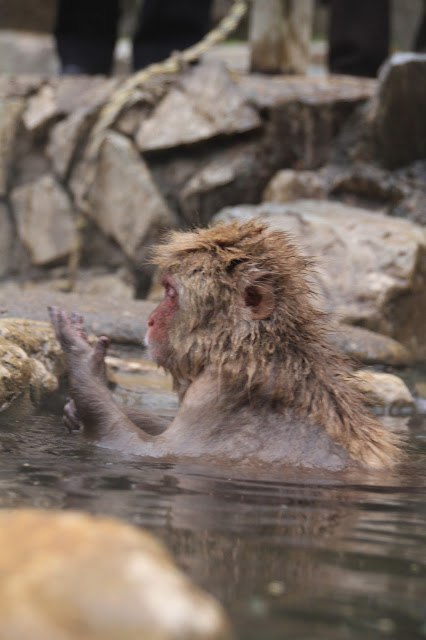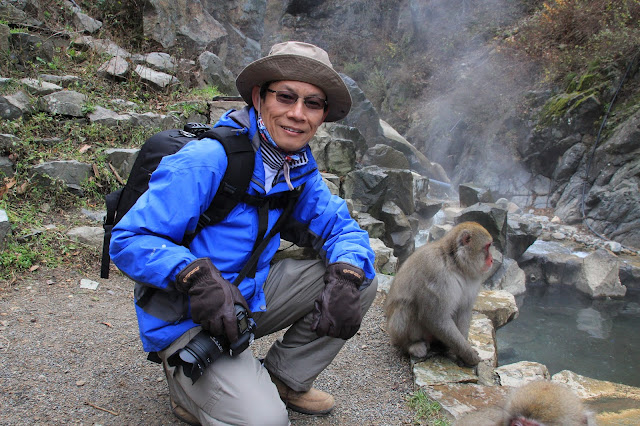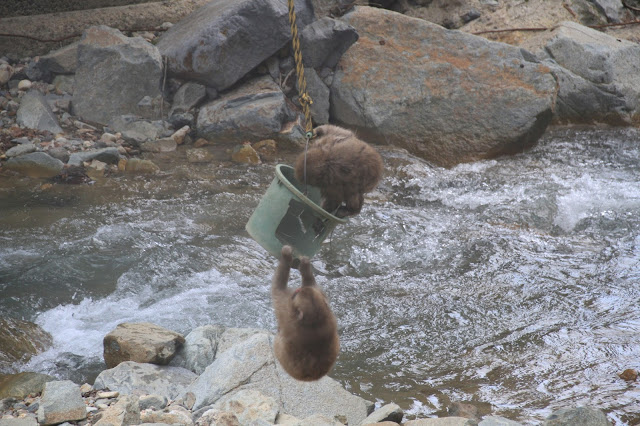Today we had only one main attraction we wanted to visit. That was the Jigokundani Monkey Park. After the park we would drive all the way to Yokohama for the night. The drive from the monkey park to Yohohama city was estimated to be about 4 hours, so I had planned for two stop breaks along the way, one at Karuizawa and another at Kawagoe.
At Karuizawa and Kawagoe I had picked up some attractions where we might want to visit if we had the time. We had chosen to pass the night in Yokohama so that our driving distance for the next day would be shorter.
 |
| Route for the day |
Jigokudani Monkey Park
This is the the monkey park where the famous Japanese snow monkeys could be seen. Ever since I watched a documentary programme on the snow monkeys of Japan I had always wanted to see them up close one day. These snow monkeys are Japanese macaque and they live in areas that are covered in snow for months each year. The special highlight at Jigokundani Monkey Park is that visitors will be able to see these snow monkey soaking in the hot spring bath to keep themselves warm when the weather turns cold.
The drive from our hotel to the car park that was nearest to the monkey park was about 45 minutes for a distance of 35 km. The last stretch of the road of about 2.5km to the car park was narrow and would be closed to vehicle in winter. We were still about two to three weeks to winter so I was pretty confident that we would have no issue driving right up to the car park.
 |
| Car Park 1 (mapcode: 341 820 583*17), Car Park 2 (mapcode: 341 820 489*87) |
The car park very large, it was except for one other car and a couple. I was surprised that even though the car park was in such a remote area, there was a car park attendant collecting car park fee, at ¥500 per entry. From the car park we followed the direction as indicated by a "Monkey Park" signboard to start our 15 minutes walk to the monkey park.
 |
| Path from carpark to Monkey Park |
The walk to the monkey park was relatively easy as the walking path was tarred though it was not wheelchair friendly. As we proceeded we passed Yokoyu river, a bridge and some ryokans and restaurants. The scenery was not spectacular as the autumn color was probably long gone and the white winter had yet to arrive.
 |
| On the way to the Jigokundani Monkey park |
We paid a fee of ¥500 per person at the entrance to the Jigokudani Monkey Park. Walking though the entrance we immediately encountered our first monkey. A flurry and bored creature that totally disregarded our presence.
 |
| Snow Monkey |
There were strict rules in the park that prohibit visitors from feeding or touching the monkeys. So it was not surprising that the monkeys did not look toward humans for food and probably also the reason these flurry creatures were not curious about the humans that were walking among them.
 |
| Monkey Monkey Everywhere |
At the bottom of the valley was a man-made open air hot spring bath. Apparently the bath was built specially for the monkeys so that they would not invade other hot spring baths in the nearby Ryokans meant for humans. The weather was cold about 10 to 12 degree celcius but not cold enough to make the many monkeys to seek out the hot spring bath.
Occasionally when one of two monkeys went into the pool, they got all the human visitors so excited and everybody went clicking their cameras away.
 |
| Having fun |
I believed the keeper of the monkey park must have threw some "monkey food" into the water to encourage the monkeys to go into the water. Those monkeys that were in the hot spring bath were constantly picking up food from the bottom of the bath and popping them into their mouths.
History said that food was the reason that beckoned the first snow monkey to walk into a hot spa. The weather was very cold and the snow monkey found that the hot spring water could provide the badly needed warm. Soon the monkey tribe learned about the benefit of submerging in hot spring water and soaking in hot spring bath become their habits during winter season.
 |
| Cleaning? |
 |
| Picking food |
The monkeys were more interested in sitting on the ledge around the perimeter of the bath than getting into the water. They were not intimidated by the humans standing among them. I could not resist walking up close to a monkey and squatting down to its level but the monkey would not even give me a second glance.
 |
| back to back |
These monkeys had pink faces and pink rumps and white light brownish color thick fur. They lived in clans with hierarchy and rank within the clan. A clan consisted of several adult males, adult females and their babies, total 5-30 individuals or sometimes more than 100 individuals. Some clans were more powerful than others.
The hot spring spa was usually monopolised by the monkeys from the more powerful clans and they would quickly chase out monkeys from the weaker clans from using the hot spring.
 |
| Monkey and I |
As human I would imagine that a monkey upon leaving the hot spring, its water soaked hair would freeze its body, this concept was not correct. Snow monkeys have very little sweat glands so they do not lose much body heat after leaving the hot spring and do not freeze.
This park had no fence and this allowed the monkeys (wild monkeys) to come in and out of the park at their wills.
 |
| Yat Thong and monkey |
The attraction at the park for the monkeys were food (barley, soy beans or apples depending on weather and season) which could only be provided by the keeper of the park.
The monkey park was just one of the places these monkeys visit, their habitats extended deep into the mountains and forest. They were attracted to the park because the food provided at the park was a bit better than the food that the monkeys usually get in the mountains and the monkeys were aware of it. Besides food the hot spring bath was another attraction to the monkeys when the weather turned very cold.
 |
| So cute!!! |
We had thought of excluding Jigokudani Monkey Park visit in our itinerary as most of the online materials I had read recommended to visit the park in winter when visitors would get to see many monkeys soaking in the hot spring as snow fall around them.
We could only visit the monkey park near the end of November which was not winter yet. I was not too sure if there would be monkeys at the park or would they go into the hot spring. Our primary reason to visit this monkey park was to see snow monkey soaking in the hot spring without that the visit would be a wasted trip.
It was great that the monkey park website had a live camera pointing at the hot spring bath and kept hourly archived images, this allowed me to monitor the monkey presence around the hot spring. As the day drew nearer to our visit, we noticed more sightings of monkey soaking in the hot spring. Finally when we arrived at the park we were not disappointed. There might not be many monkeys soaking in the hot spring or white snow blanketing the entire place we still enjoyed our visit very much.
Somehow just to be able to see one monkey soaking or diving in the hot spring bath made this visit well worth it.
 |
| Monkeying around |
Karuizawa
On our way to Yokohama we stop at Karuizawa town for lunch. The distance from the monkey park to Karuizawa was about 100km and the drive took about one and three quarter hours. Karuizawa is one of the resort towns along the Japan's Romantic Road and is highly popular with visitors. It offers nice autumn color from mid October to early November.
When we drove into town we were very surprise to see that the town was very quiet, in fact very deserted. There were hardly any visitors or vehicles on the road. The lack of visitors could be because the autumn color at Karuizawa was long gone added with the fact that we were in Karuizawa on a weekday which was not a time for visitors to be in this resort town.
It was close to 2 pm and we still had another two and three quarter hours of driving ahead before we could reach Yokohama. In Karuizawa, I had identified two possible attractions to visit. One was the Kyu-Karuizawa Trick Art Amusement Museum and the other was the Stone Church. Visiting either one would mean another 2 hours of time needed. After much consideration we decided to drop both attractions and save the time for a leisure lunch. We walked into this restaurant called Kastanie Rotisserie to have our lunch.
 |
| Cafe latte |
Kastanie Rotisserie was just next to Hachijuni Bank which had a car park behind the bank that was where we parked our car.
We picked out this restaurant randomly and surprising its food was very good. We had roast chicken and pizza and absolutely love them. Since the beginning of this Japan trip we had been eating mainly Japanese food. Today was the first time we ate western food and it made me realised how much I missed them. The meal was completed with two cups of aromatic cafe latte. It was nice to take it slow today, to loiter around over a meal.
We left Kastanie Rotisserie at about 3.30 pm and drove straight to Yokohoma. Though we drove passed Kawagoe we did not stop at its main attraction, Koedo Kawagoe, an ancient merchant town with preserved structures and buildings dating back to the edo-era. In the last 11 days we had seen many edo-era towns such as Higashiyama District in Kyoto and Magome and Narai post towns in Kiso valley so we did not feel the need to visit Koedo Kawagoe.
Yokohoma
It was a long drive from Karuizawa to Yokohoma, 210km in 2 hours and 45 minutes. After we checked in to our hotel it was already close to 7pm. We felt a sense of relief as we had completed our journey for the day. After leaving our luggage in the room we came out of the hotel to explore the port city. Our hotel was just near the waterfront and the lighted city landscape was very lovely.
 |
| Yokohama Port |
The tall skyscapers, the gigantic ferry wheel, the tall shopping malls and the cruise ship by the port were so colourfully lighted. We kept walking forward toward the next lighted structure, and soon we were a few kilometers from our hotel.
 |
| Cruise Ship docked at Yokohama Port |
From afar, the lighted huge ferry wheel piqued our interests and we walked toward it. It was part of the CosmoWorld, an amusement park. Though the amusement park was brightly lighted we could not see any visitors. It was about 8.10pm and I wondered if the amusement park was closed for the day.
 |
| Cosmo World |
We walked past Yokohama Ramen Museum but did not went in to explore as we decided that if we were not going to eat ramen there was no point going in. We passed several shopping malls on the outside and was more excited about its lighted facade then going in. Somehow without a crowd of shoppers around the urge to shop or window shop diminished.
Though the whole place was very quiet and deserted, we did not at anytime felt unsafe walking on the streets. This was probably because Japan has a good reputation of being a "safe" country, Yokohama streets were squeaky clean, there was no sign of graffiti and the few people we saw on the roads were neatly dressed so we did not feel any sense of danger.
 |
| World Porters |
Yokohama is the second largest city in Japan by population. It is the capital city of Kanagawa Prefecture and it lies on Tokyo Bay. It has a population of 3.7 millions and is considered one of Japan major ports.
Yokohama in the 18th century was a small fishing village. It turning point came when it was designated as the port for foreign ships to dock. It became the base of foreign trade in Japan.
After an hour of walking we decided that we had to turn back or we would be getting further and further from our hotel. We were very glad that we had ventured out to explore Yokohama port and experience its beautiful lighted skyline.
 |
| Walking route at Yokohama Port Waterfront |
Hotel for the Night at Yokohama
 |
| JAL City |
Our hotel at Yokohama was Hotel JAL City Kannai Yokohama. We booked into a twin room at ¥7,650 a night with ensuite bathroom, no meal and parking on site was ¥1500 a day. The hotel was nice, clean and comfortable.
Whenever we were in a big city we would prefer a room on the higher floor as we wanted to view the lighted city from above. So at the point of booking a room with this hotel I had requested for a room on a high floor, unfortunately upon checking in we were put on the lower floor.
The front desk staff told us that whether we were on the high or low floor there would be no city view as the buildings were too close to each other and the city views were blocked. On hind sight I believed that this "blocked views" was a blessing because it forced us to come out of our hotel room and explore Yokohama port on foot which was a wonderful experience.
